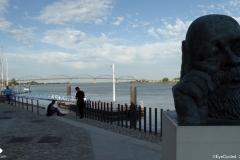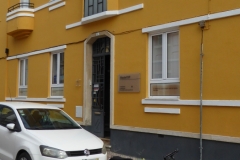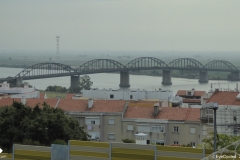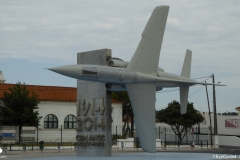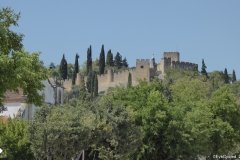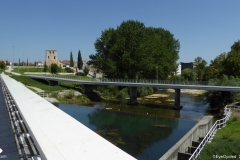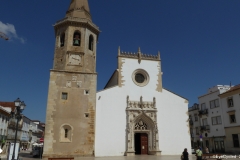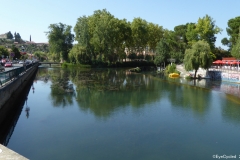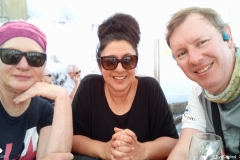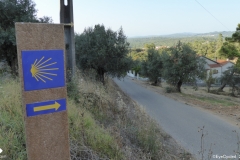This post is "natively" only available in English.
Between the 25th of August and the 4th of September 2019 I cycled nearly 660 Km on the Portuguese Way of the Camino de Santiago, from Lisbon to Santiago de Compostela in Spain.

I recorded a short vlog about this trip a week before I left. In this video I explained my motivation to do this pilgrimage, so I will not repeat myself and go straight to the point with this introduction.
Upon my return, I’ve asked a few friends that have, and have not, done pilgrimages before, what would they find useful in this introduction and they asked me 7 questions in return.
I have answered all 7 questions in the video below, together with a photo show of the 210 pictures I liked most out of the thousands I took during the journey. I’ve added them to a photo gallery on the bottom of this post, in case you want to see them in a higher resolution.
If you don’t like to read, I essentially talk through these questions in the video, but in the text below I added a little more detail.
The 7 questions I got were: (Click to jump to the answer)
- How long did the pilgrimage take? (Time)
- How much did you spend? (Expenses, Cost)
- Was finding the way easy? (Navigation)
- What were the worst experiences you had on the Camino?
- What were the best experiences you had on the Camino?
- How Safe is the Camino?
- Where did you sleep? (accommodation)
Click here to jump to the picture gallery.
-
- How long did the pilgrimage take?
For me it took 11 days! Started from the Sé Cathedral in Lisbon on Sunday, the 25th of August, around 12 noon and arrived in Santiago on Wednesday, the 4th of September, around 4:00pm.
Back to Top - How much did you spend?
I spent €685.42 in the entire journey. That includes all expenses from the moment I arrived at London Heathrow Airport, on my way to Lisbon, to the moment I left Santiago de Compostela. It also includes the fees I had to pay to the airlines (TAP and Iberia) for transporting my bike. As you may not live in London, or in the UK, your journey to Portugal and from Spain may be quite different than mine, so if you only count the pilgrimage days, the total expense was €451.14 and as it took me 11 days to reach Santiago, the average per day was €41.01.
I’ve created a Google Sheets page containing all my expenses, as well as the telemetry from my Garmin Devices, such as distances travelled, altimetry, average heart rate and so an.
I believe it is entirely possible to do the Camino spending much less than I did, but perhaps you’ll have to limit yourself to eating only 2 meals a day, cook your own food and just walk and sleep. If you plan to do the Camino with as little as possible, I would recommend that you reserve a minimum of €30 a day for your journey.
If you are looking to stay at “Donativos” (hostels where you pay just as much as you can) or accommodation under €12 a night you will find it somewhat challenging, especially in Portugal, as the number of beds in such places is small and fills up quite quickly. The cheapest albergue I stayed in these 11 days charged €6 a night. It was in Briallos (ES) and it was a publicly owned “Xunta de Galicia” albergue. Keep in mind there is a price rise expected for all “Xunta” albergues in 2020 (I think they’ll go up to €9 a night). I am not aware of any accommodation under €12 a night in Portugal. The “Casa do Sardão” hostel, was one of the most typical and attractive albergues I stayed in Portugal and it charges pilgrims €12 for a bed (well worth it though).
Back to Top - Navigation: Was finding the way easy?
The answer to this question is not a yes or no. In Lisbon there are very few signs pointing the way. I found only 3 and 2 were very faint. Signage improves after Coimbra, but you’ll still find stages where signage is excellent and others where signage is poor. After Porto, signage tends to be very good, however, if you are cycling you have to keep in mind the original Camino is meant for walking, not cycling, so there are signs pointing to ways you cannot (or should not) ride on your bike.
I am also almost certain there were arrows pointing to disused paths of the way as the Camino appears to have changed over the years. I frequently stopped to ask for directions and some locals said a few times, pointing with their fingers, “it used to go that way, but now it goes this way”. Remember that, generally, walkers go against traffic and cyclists move with traffic. That means if you are cycling, most signs will be on the opposite side to you and they are typically small and not always easy to see. Taking into consideration you have to be aware of the traffic around you, finding a little sign, sometimes 20 – 30 m away, takes a lot of attention and good eyesight. It becomes a game of “find the yellow arrow”. Sometimes you win, sometimes you lose. Considering the number of times I got lost and had to rely on Google Maps or the Map loaded on my Garmin Edge 820, my route was actually pretty close to the “official” route of the Camino, if there is such a thing.
My recommendation is that you search for the GPX file of the Portuguese Way (I found this one wich became my reference route), download it, open it with Google Earth (or other such software) and study the way. That helped me find the way out of Lisbon with relative ease. I will also post copies of my own route in the blog, but they will contain the mistakes I’ve made. There is a gap of about 10 Km in my GPX route, as having the navigation feature always on in the Garmin caused the device to consume a lot more battery and that caught me by surprise as I was about 10 Km from Azinhaga on the 2nd day of the Camino and the Garmin Edge suddenly “died” (my Garmin Forerunner watch had already died earlier that day). In my usual bike touring rides the battery of the Garmin Edge 820 I use lasts for at least a couple of days, but without the use of the navigation feature.
Back to Top - What were the worst experiences you had on the Camino?
There were moments of frustration, no doubt, but I honestly cannot complain. I have not suffered any injury, nor had a mechanical fault that prevented me from continuing, nor was a victim of any “bad intentions” like theft, aggression, etc. I think if any of these things had happened, I would have a good reason to highlight them here.
With that in mind, some of the lighter frustrations came from…
– The airlines that damaged my bike in transportation and charged me extra to transport them on top of what I had already paid for luggage;
– My own mistakes;
– The amount of urban traffic in some places and
– The poor signage in others.I also found it difficult to find pilgrim accommodation in some places after 4:00pm and had to resort to staying in more expensive places, but that would only have been a real problem if I could not afford them. Since I gave myself a comfortable budget to do this pilgrimage, this was not an issue for me. I was, however, committed to try to do the Camino as much as possible in a “pilgrim’s honoured” way.
Some frustration also came from the challenging type of terrain I had to face with a heavy bike and the fact I was somewhat unprepared for that level of difficulty. Again, this is no one’s fault, but my own. The Camino, following the yellow arrows, is very challenging for cyclists. It’s absolutely not meant for touring bikes, so I would recommend you evaluate this well before you leave. If you plan to follow the yellow arrows on a bike, a sturdy mountain bike is highly desirable. Also, from Lisbon to about Coimbra, the Camino is very urban in most parts. Done on busy roads and going through industrial areas. Not exactly the notion of nature’s paradise one would expect.
This was also one cycling trip in which I got very frustrated with my tech, much of it due to my own fault as well. These include video recording hiccups, which meant I have no footage for a portion of the Camino or when both my Garmin devices ran out of battery as I explained before (“Strava cyclists” will understand the frustration).
Back to Top - What were the best experiences you had on the Camino?
Honestly, just doing it! It’s not the destination, it’s the journey. I loved the views of the many places I’ve been through and the people I met with whom I had a chance to have a conversation with, in the hostels I stayed and even if just cycling very slowly alongside them for a few minutes. If any of them is reading this, I am so grateful for the opportunity to get to know you, hear your stories, your reasons for doing the Camino and other experiences you had as pilgrims.
Some of the best experiences also came from the most challenging ones. The times I looked up a hill and thought I would not be able to climb it up, but then I did. Obviously hills are supposed to be hard to climb, but the reward when you get up there is not just the feeling of accomplishment, but the visual delights of the views. Other worthwhile experiences include things like the sounds and smells of the forests I cycled through or the coastal paths I cycled by.
And then, there was also the simple culinary delights of a 3 course pilgrims menu, typically for less than €10 in some places, which often included excellent local wines. In Carreço, Portugal, the pilgrim’s menu at Sergio’s included a starter, a main course, desert and a full bottle of white all for €8.50. A pilgrimage is certainly not a dream holiday for many, but then a pilgrimage is often only a holiday in the sense that those who, like me, live busy professional lives, can only do them during their holidays, hence the reason young people on a gap year and retired people seem to be dominant on the Camino.
People go on pilgrimage for a multitude of reasons, but certainly not to lay down and relax. It is quite demanding physically, even if you are fit and in a good state of health. The paths are more often than not full of sand, gravel, stones, mud and boulders which becomes especially difficult if you are climbing up or even going down steep hills.
Back to Top - How Safe is the Camino?
All I can tell you is that I had no issues whatsoever in my Camino. There were moments I left my bike completely unattended with almost everything on it (with the exception of my documents, money and the more expensive electronic equipment). In some of these moments I locked the bike, like when I entered the Sé Cathedral in Lisbon and then at the Paroquia Dos Martires church as I was looking to buy a pilgrim’s credential which I had forgotten back home. In these moments the bike was outside on a very busy central location for at least 30 min and nothing was missing when I came back.
I also felt safe cycling on the roads, despite the heavy traffic in places. There were a few exceptions in which I thought some drivers drove a bit too close for comfort, but in the vast majority of times the Portuguese and Spanish drivers respected a safe distance. I cannot stress enough though that some roads are really busy and you should always be careful, regardless if walking or cycling the Camino. Walkers will have to walk on roads and hard shoulders in several occasions too.
Despite all of this, I can’t think of one moment in which I felt like I was in serious risk.
Back to Top - Where did you sleep? (Accommodation)
The network of pilgrims’ hostels, or Albergues as they are known, is not as extensive in the Portuguese Way as it is on the French Way (from Saint Jean Pied de Port), yet that doesn’t mean it is not sufficient.
I used 2 resources to find accommodation: 1) Gronze.com: Probably one of the best online resources for all Caminos to Santiago. One catch is that the site is only available in Spanish, but you can use Google Translate to automatically (machine) translate the site. The site gives you all stages for all Caminos and a list of accommodations for each stage, which include not only pilgrims’ hostels, but hotels and other types of accommodation as well (camping areas, etc).2) A Google Sheet list of (currently) 536 places along the Portuguese Way of the Camino (all variants: Lisbon-Porto, Coastal, Central and Spiritual), created by a user named “Anonymous Goose”.This is a great resource, maintained by volunteers and frequently updated based on information received by pilgrims. The list gives you the phone numbers for all the places, in addition to estimated cost, number of beds, type of accommodation, website (when available) and physical address as well as recommendations. The list is extensive, but I printed it and used it together with the printed Gronze stages (only carried in my handlebar bag the sheets for the stages I was planning to do for that day).
As far as my own experience goes, the places I stayed are all listed in the Google Sheets page I mentioned in question #2. I can only say that they were all clean, comfortable and functional, some even luxurious for pilgrimage standards. I am not going to say more than that as what you expect for your Camino might be very different from mine, but if you choose to stay in the same places I did, I can recommend all of them to you. Few important things to mention for cyclists, although this wasn’t an issue for me, not all places I stayed had a space to store the bike. I think I was lucky that in the places where that could have been a problem, I was the only cyclist that night, so it was always possible to find a little corner to leave the bike. For example in Coimbra I left the bike at the reception by the exit door of the hotel I stayed. If there were more bikes that night, that would have been a problem as the space was quite tight.Back to Top
- How long did the pilgrimage take?
So these are the 7 questions I received, but if I missed something you want to know, or if you have other questions or want more detail about my experiences on the Portuguese Way of the Camino de Santiago (while you wait for the Blog posts to be written and the videos to be published), just get in touch by leaving a comment here or message me through the contact form in the Blog.
Bom Caminho! Buen Camino!
Picture Gallery.
Click on any picture for full detail
Back to Top
Do you like these posts? Why, then, don’t you pay me a coffee to help with the blog hosting cost and as a caffeine incentive to keep me going through the long hours of the night? (Suggested amount: £2.00 or USD $3.00 or 2.50€ or whatever you want to give). You may donate through my Patreon Page or through PayPal directly. ![]()
![]()
















